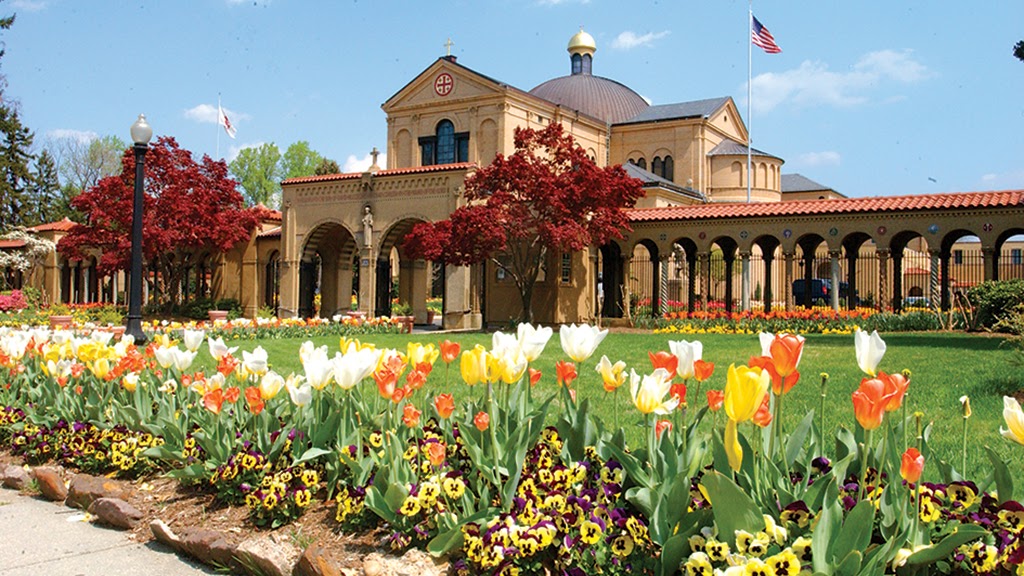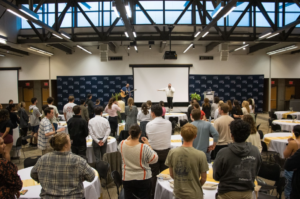Hidden Brookland Gem: The Franciscan Monastery of the Holy Land

By Katie Van Lew
Catholic University, situated in the heart of Brookland and conveniently located near the metro, allows students to explore the city at their leisure. Although the allure of monuments, museums, and nightlife captivates most students, Brookland is home to a hidden gem— more specifically, the Franciscan Monastery of the Holy Land.
The monastery is about a mile walk from CUA, located on 1400 Quincy St NE, Washington, DC 20017.
On Saturday, the CUA Environmental Club organized a trip to the Franciscan Monastery to explore the beautiful gardens encompassing the church. The club decided to tour the monastic gardens because St. Francis of Assisi is the patron saint of the Environment. During the spring, the visitors are encouraged to take a tour of the upper, lower, and vegetable gardens adorning the monastery.
“Our group had a wonderful time touring the monastery,” said Taylor Capobianco, the vice president of the Catholic University environmental club. “It was gorgeous and there was so much to learn from looking at the mosaics and paintings that were there. It was also very cool when we found out that they did not just replicate the churches from the holy lands but also the underground catacombs. It was a very moving experience walking down those tunnels looking at the paintings of Christain martyrs.”
The tour, which takes students through the beautiful gardens, simultaneously immerses students in the history of the Franciscan monastery. Between the natural beauty of the gardens, and the many pieces of art on display, students enjoyed a gorgeous Saturday afternoon spent reflective on the environment and their faith.
“We had a great time at the monastery touring the church and gardens and learning more about the symbolism behind the various altars and statues throughout,” said fellow vice president Scott Connor. “We also got to explore the catacombs, which was an unexpected yet incredible experience.Throughout the visit, we encountered several connections to animals and the environment, which helped us connect faith and environmental issues.”
Built by The Custody of the Franciscans in 1899, the Franciscan Monastery serves many purposes for the Catholic community. First and foremost, the monastery acts as a sanctuary for people desiring to experience a spiritual pilgrimage. The beauty and sanctity of the church attracts nearly 50,000 people annually, with the majority of people seeking to witness the plethora of replicas within the church. Additionally, the monastery is purposed to train Franciscans for the Holy Land. The monastery also focuses on raising funds and awareness. On Good Friday, churches have a special collection taken up for the Holy Land, which is then sent to the Franciscan Monastery and then distributed to the Custody of the Franciscans for their continued work.
In many ways, the structure of the church resembles the Church of the Holy Sepulchre in Jerusalem. In the upper church, there are three replicas from the Church of the Holy Sepulchre. The church itself is not a copy of the church in Jerusalem, but instead was structured in a way that resembles the Jerusalem cross, with four crosses in the corner of the church representing the five wounds of Christ.
Several chapels are dedicated to pivotal saints, including chapels dedicated to Joseph, Saint Francis of Assisi, the Blessed Mother Mary, and Saint Anthony.
Within the main church, there is a replica of the Edicule that enclosed the empty tomb of Christ. The Edicule in the Franciscan Monastery differs from the one in Jerusalem as Jerusalem’s is freestanding whereas the Franciscan Monastery’s is built into the wall, but the dimensions are the same. Inside, there are two rooms: the room where the angel announced resurrection to Mary Magdalene and the burial chamber in which Christ was laid to rest. The distance between Cavalry and the tomb is the same distance that is in Jerusalem. The Edicule exhibits a beautiful depiction of the transfiguration, where Jesus’ face is shining like the sun as he is surrounded by his Apostles.
There are several altars throughout the church, each one with its own specific purpose. There is an altar dedicated to the Holy Spirit, with a depiction of a dove being worshipped by angels. Encapsulating the Holy Spirit are the symbols of the four evangelists, the Gospel writers. Across the church, there is a landing with a white altar which is a replica of the altar of Calvary from the church of the Holy Sepulchre. Above the landing, a large panel displays the crucifixion of Jesus. In the center of the church, an altar is enveloped by a canopy, called the Baldaquino. Constructed of bronze, the columns are adorned by statues exhibiting the twelve Apostles. Above the altar, there is a dome painted in enamel and dedicated to the blessed mother.
The church is accentuated by pristine, stained glass which depicts the Franciscan saints. The stained glass came from Bavaria, Germany and was installed in 1931.
Underneath the church, the Christian catacombs hold the bones of Saint Benignus and many sculptures of martyred saints such as Saint Cecilia. Within the catacombs lies the Purgatory Chapel, which is utilized for mass on All Souls’ Day. This chapel is symbolic of the pouring of water on souls, with the blessed mother comforting souls. The Franciscan Monastery of the Holy Land is a serene sanctuary for all people seeking a spiritual renewal and reaffirmation of their faith. The monastery hosts daily pilgrimages, giving tours of the church, catacombs, and gardens daily to those who wish to visit. The gardens are open for all to explore at their own leisure from 9:00 a.m.-4:45 p.m. everyday. Garden tours entail an immersive garden excursion that explores the history, architecture, plants, and friars associated with the garden.






